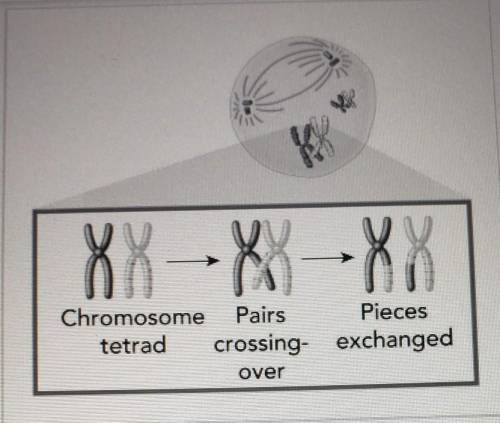luxmimspcbcxf
14.12.2020 •
Biology
Meiosis is a process in which the number of chromosomes per cell is cut in half through the separation of homologous chromosomes in a diploid cell. Meiosis usually involves two distinct divisions called meiosis I and meiosis II. By the end of meiosis, a single diploid cell has produced four haploid cells.
After interphase I, the cell begins to divide, and the chromosomes pair up. In prophase 1 of meiosis, each replicated chromosome pairs with its corresponding homologous chromosome. This pairing forms a structure called a tetrad, which contains four chromatids. As the chromosomes pair, they sometimes undergo a process called crossing-over.
Which is a true statement of crossing-over?
A. Homologous chromosomes move to opposite ends of dividing cells
B. During crossing-over, bits and pieces of the homologous chromosomes are exchanged
C. The DNA of the diploid cell is copied
D. Crossing over decreases genetic diversity

Solved
Show answers
More tips
- A Art and Culture Who Said The Less We Love a Woman, the More She Likes Us ?...
- F Family and Home Parents or Environment: Who Has the Most Influence on a Child s Upbringing?...
- H Health and Medicine Is it true that working with a computer is harmful to your eyesight?...
- H Health and Medicine Boosting Immunity: A Complete Guide on How to Improve Your Body’s Natural Defenses...
- P Philosophy Unidentified Flying Object - What is the Nature of this Phenomenon?...
- C Computers and Internet How to Teach Older Generations to Work with Computers?...
- G Goods and services How to Choose a Coffee Maker? The Ultimate Guide for Coffee Lovers...
- C Computers and Internet Porn Banner: What It Is and How to Get Rid Of It?...
- F Food and Cooking How many stages of coffee roasting are there?...
- F Food and Cooking From Latte to Espresso: Which Coffee Drink is the Most Popular on Earth?...
Answers on questions: Biology
- B Biology How is this similar or different from the way energy hit carbon dioxide or methane?...
- B Biology What is meant by “non-Mendelian inheritance”? State two factors that result in this form of inheritance....
- B Biology 1. A certain genetic disorder causes affected women to have patches of skin with very few sweat glands. The disorder also occurs in males. In females, could the...
- B Biology Pretend the coastal town of Galveston, TX has decided to install new wave generators on all its beaches to create energy for the entire island. What disadvantages...
- B Biology Someone help me pleaseeseeddddffggvvbbb...
- B Biology Evolutionary success is often described as “survival of the fittest,” which can be misleading. Which statement better explains the concept of evolutionary success?...
- B Biology How many hydrogen bonds are between A and T, and C and G?...
- B Biology What is true about the particles in a substance? Select all that apply. Particles in all states of matter are constantly moving. The way particles move changes when...
- B Biology Practice photographing different animals. You can choose your pets, zoo animals, or wild animals nearby. (Remember to stay safe and use caution when photographing...
- B Biology Awolf population is living in an arctic climate. the wolf has a dominant trait for short fur and a recessive trait for long fur. wolves with long fur are more likely...

Ответ:
B.
Explanation:
D is wrong because it Increases gentetic diversity
C we are talking about the chromosome not the cell
A That is later on in telophase I
Ответ:
I believe it's B, but I'm not 100%